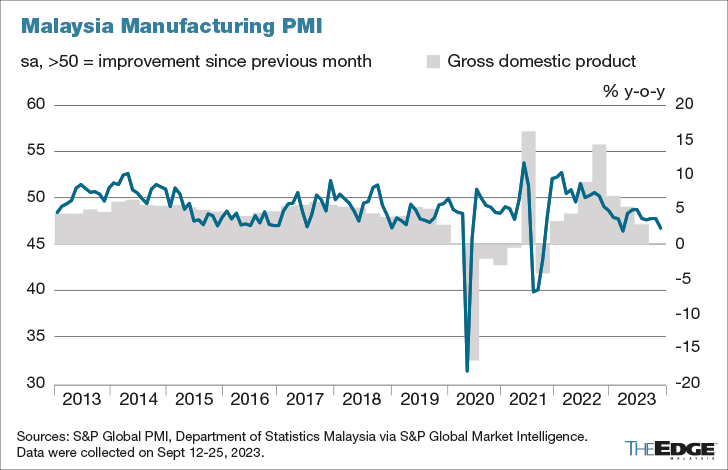
Photo by Shahrill Basri/The Edge
KUALA LUMPUR (Oct 2): Malaysian manufacturers reported demand weakness at the end of the third quarter of 2023, and this was evident across a range of indicators in the latest purchasing managers index (PMI) data.
In a statement on Monday, S&P Global Market Intelligence said output and new orders both moderated to a greater extent than in August, while new export orders fell at the third-strongest pace in the series history.
Moreover, it said employment levels fell for the fifth month running, while purchasing activity softened to the greatest degree since September 2021.
This weakness in demand for inputs also fed through into stocks of purchases.
A degree of spare capacity in the sector was signalled, as the level of outstanding business was depleted at one of the strongest rates in the series history since July 2012.
The seasonally adjusted S&P Global Malaysia PMI posted 46.8 in September, down from 47.8 in August.
The latest reading signalled further challenges for firms in the manufacturing sector, with business conditions moderating to the greatest extent since January.
S&P Global said that looking at the relationship between the PMI data and official gross domestic product (GDP) statistics, the figures for the third quarter suggest that year-on-year GDP growth eased further from that seen in the second quarter.
It said the data are also consistent with official manufacturing production remaining broadly stable on an annual basis.
Manufacturing new orders moderated for the 13th month running in September, with the latest slowdown the sharpest in eight months amid widespread reports of demand weakness.
The subdued demand environment was not limited to the domestic market, as new export orders softened to the greatest extent since May 2020.
A lack of demand was also a key factor behind a further slowdown in production, which eased for the 14th month running and to the greatest extent since January.
S&P Global said employment moderated for the fifth month in a row in September.
It said lower workloads and staff resignations were cited as the main reasons for reduced staffing levels.
Spare capacity was also evident, with backlogs of work reducing for the 16th consecutive month, and at the steepest rate since July 2017.
Subdued demand conditions also fed through to weaker demand for inputs. Both input purchases and pre-production inventories were scaled back to the greatest extent for two years, while holdings of finished items were reduced at the quickest pace since July 2021.
Positively, supplier performance moved closer to stabilisation following a marginal deterioration in the previous survey period.
Although input costs rose, the pace of inflation was muted in the context of the past three years.
Where input prices increased, this was linked to higher raw material costs.
That said, output prices were raised at a sharper rate in September, with the rate of charge inflation the strongest seen for 10 months.
Looking to the future, Malaysian manufacturers were increasingly optimistic that the current demand weakness would fade.
As such, the overall degree of optimism reached the highest since May.
Positive sentiment was commonly attributed to hopes for an improved demand environment that would promote new order inflows and business opportunities.
That said, firms cited uncertainty regarding the timing of the recovery.
S&P Global Market Intelligence economist Usamah Bhatti said Malaysian manufacturers continued to endure a challenging time at the end of the third quarter, with reports of demand weakness widespread in the latest PMI survey, causing stronger moderations in output, new orders and exports.
He said that although the latest figures are still representative of growth in official GDP numbers, the current soft patch looks set to continue over the coming months.
“Data for the level of outstanding business signalled one of the steepest depletions in backlogs in the series history amid a sustained lack of new orders.
"Reflecting the weakness, firms are increasingly cautious regarding spending, pulling back on input purchases, stock holdings and employment levels,” he said.
- Intel jumps 10%, as investors cheer appointment of new Malaysian-born CEO Tan
- Subang’s turbulence: Malaysia’s airport expansion faces market realities
- UWC's 2Q net profit more than doubles on semiconductor industry's strong recovery
- Apollo Food 3Q net profit drops 66% on lower margin, absence of one-off gains
- Taghill Holdings sues developer to recover outstanding payment
- Putin backs US ceasefire idea for Ukraine, but says many details need to be sorted out
- Democrats in standoff with GOP as US shutdown deadline nears
- Vocational college murder case: Third accused says did not see victim steal money
- Anglo American plans fresh job cuts at corporate office under restructuring
- Ontario fund hires Alexander Fraser as its global head of private equity

